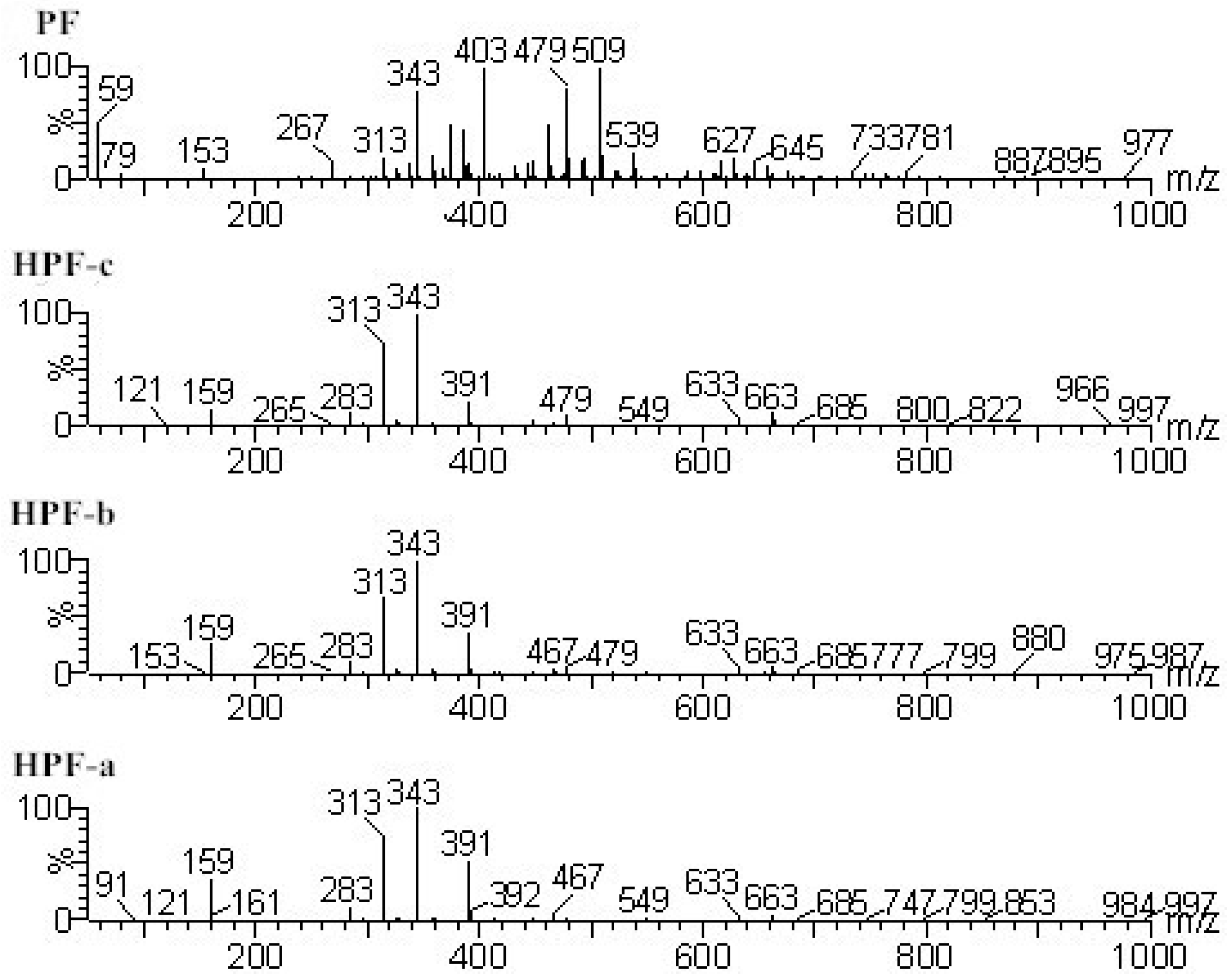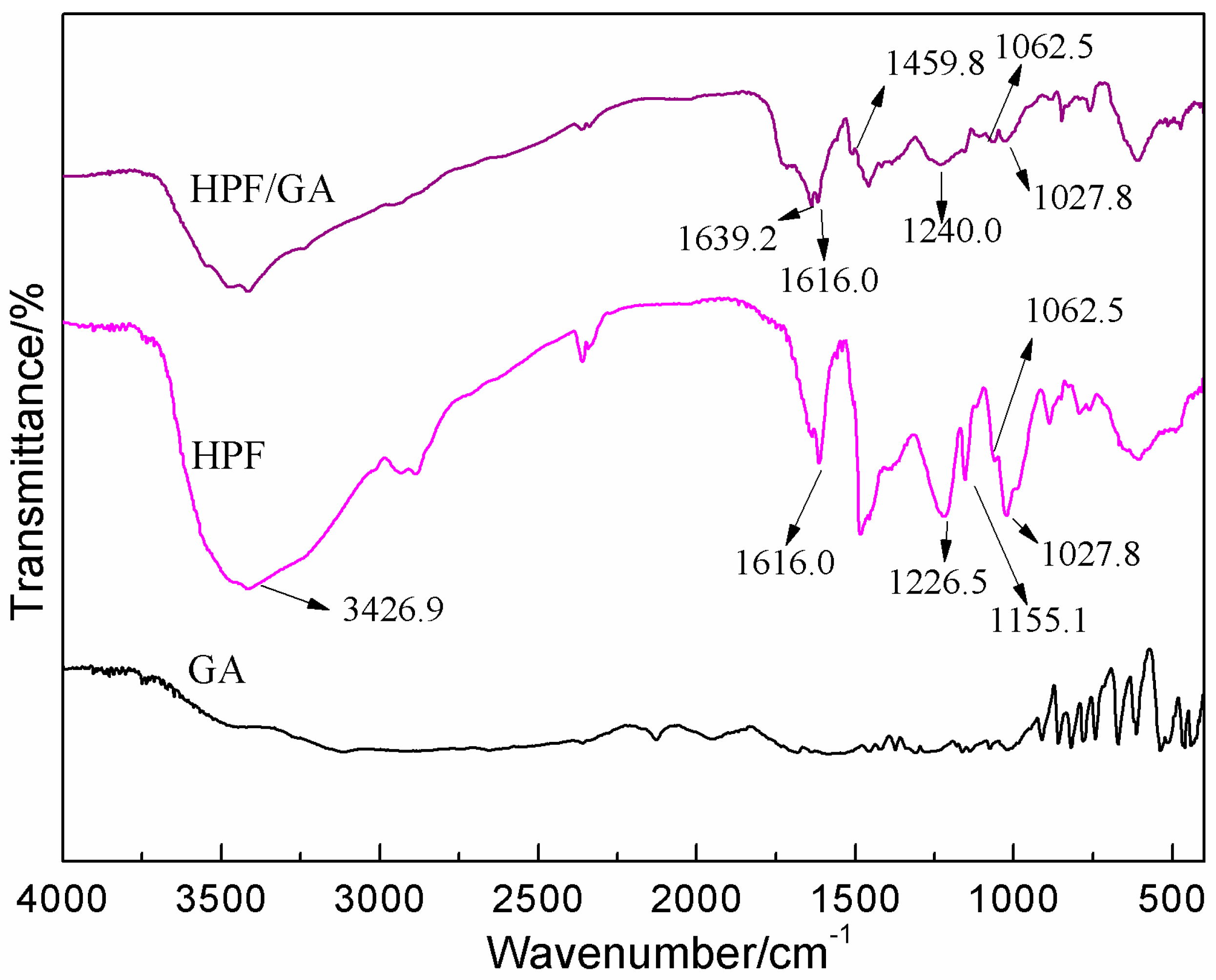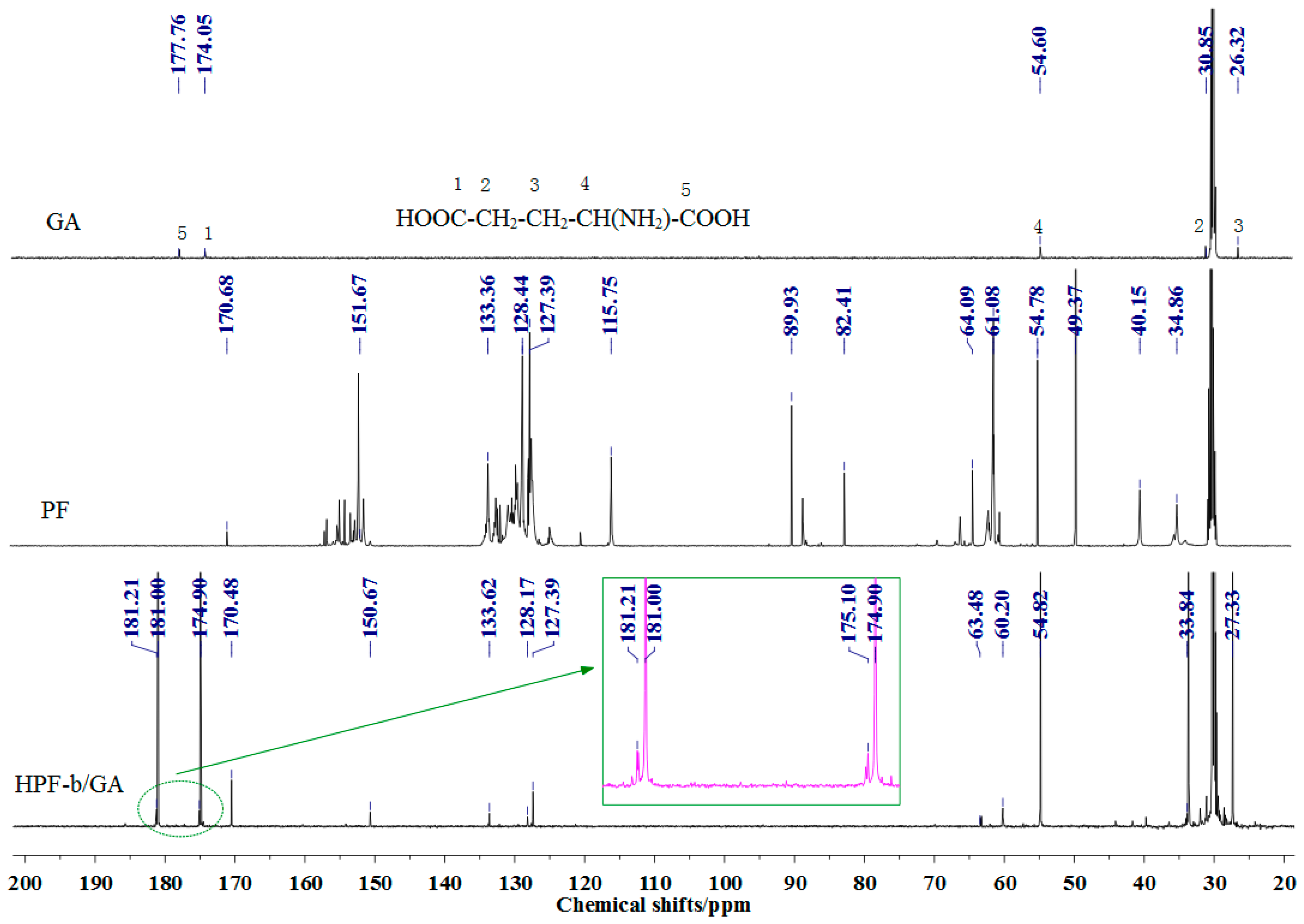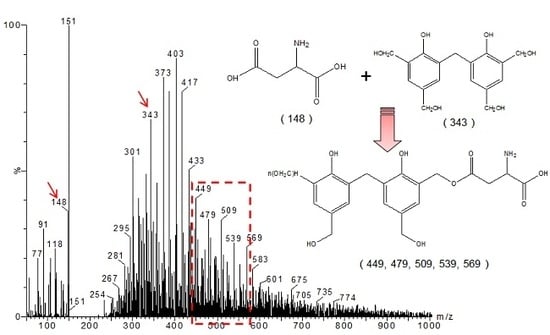Study on Soy-Based Adhesives Enhanced by Phenol Formaldehyde Cross-Linker
Abstract
:1. Introduction
2. Materials and Methods
2.1. Materials
2.2. Preparation of PF Resin-Based Cross-Linker
2.3. Preparation of Soy-Based Adhesive
2.4. Verification Experiment on Reaction between PF Resin and Soy-Based Adhesive
2.5. Preparation of Plywood with Soy Protein-Based Adhesive
2.6. Test of Dry and Wet Shear Strength of Plywood Samples
2.7. ESI-MS
2.8. 13C-NMR
2.9. FT-IR
3. Results and Discussion
3.1. The Chemical Structure of Hydroxymethyl Phenol
3.2. The Interaction between HPF and Soy Protein
3.3. Performance of Soy Protein-Based Adhesives Cross-Linked by Hydroxymethyl Phenol
4. Conclusions
Author Contributions
Acknowledgments
Conflicts of Interest
References
- Lei, H.; Wu, Z.; Du, G. Cross-linked soy-based wood adhesives for plywood. Int. J. Adhes. Adhes. 2014, 50, 199–203. [Google Scholar] [CrossRef]
- Guo, M.; Wang, G. Milk Protein Polymer and Its Application in Environmentally Safe Adhesives. Polymers 2016, 8, 324. [Google Scholar] [CrossRef]
- Gao, Q.; Shi, Q.; Zhang, S. Soybean meal-based adhesive enhanced by MUF resin. J. Appl. Polym. Sci. 2012, 125, 3676–3681. [Google Scholar] [CrossRef]
- Fan, D.; Qin, T.; Chu, F. A soy flour-based adhesive reinforced by low addition of MUF resin. J. Adhes. Sci. Technol. 2011, 25, 323–333. [Google Scholar] [CrossRef]
- Jang, Y.; Huang, J.; Li, K. A new formaldehyde-free wood adhesive from renewable materials. Int. J. Adhes. Adhes. 2011, 31, 754–759. [Google Scholar] [CrossRef]
- Gao, Q.; Qin, Z.; Li, C.; Zhang, S.; Li, J. Preparation of wood adhesives based on soybean meal modified with PEGDA as a crosslinker and viscosity reducer. Bioresources 2013, 8, 5380–5391. [Google Scholar] [CrossRef]
- Lei, H.; Du, G.; Pizzi, A. Effects of glyoxal on chemical structure and properties of protein-based adhesives. J. Southwest For. Univ. China 2011, 31, 70–73. [Google Scholar]
- Lei, H.; Wu, Z.; Cao, M.; Du, G. Study on the soy protein-based wood adhesive modified by hydroxymethyl phenol. Polymers 2016, 8, 256. [Google Scholar] [CrossRef]
- Yang, I.; Kuo, M.; Myers, D.J. Bond quality of soy-based phenolic adhesives in southern pine plywood. J. Am. Oil Chem. Soc. 2006, 83, 231–237. [Google Scholar] [CrossRef]
- Hse, C.Y.; Fu, F.; Bryant, B.S. Development of formaldehyde-based wood adhesives with co-reacted phenol/soybean flour. In Green Chemistry for Adhesives, Proceedings of the Wood Adhesives 2000, South Lake Tahoe, CA, USA, 22–23 June 2000; Forest products Society: Madison, WI, USA, 2001; pp. 13–19. [Google Scholar]
- Kreibich, R.E.; Steynberg, P.J.; Hemingway, R.W. End jointing green lumber with SoyBond. In Proceedings of the Wood Residues into Revenue, Residual Wood Conference, Richmond, BC, Canada, 4–5 November 1998. [Google Scholar]
- Wu, Z.; Lei, H.; Du, G. Disruption of soy-based adhesive treated by Ca(OH)2 and NaOH. J. Adhes. Sci. Technol. 2013, 3, 1–7. [Google Scholar] [CrossRef]
- Riblett, A.; Herald, T.; Schmidt, K.; Tilley, K.A. Tyrosine Cross-Links: Molecular Basis of Gluten Structure and Function. J. Agric. Food Chem. 2001, 49, 4983–4989. [Google Scholar] [CrossRef] [PubMed]
- Lei, H.; Wu, Z.; Du, G. Application of soy protein-based adhesives modified by cross-linker. China Wood Ind. 2013, 27, 8–11. [Google Scholar]
- Lei, H.; Du, G.; Pizzi, A. Structural Progressing of Phenol-urea-formaldehyde Resin under Alkaline Condition. China Chem. Ind. For. Prod. 2009, 29, 63–68. [Google Scholar]
- Wu, Z.; Du, G.; Lei, H.; Xi, X.; Cao, M.; Guo, X. Preparation of eco-friendly urea-formaldehyde resin by urea-formaldehyde precondensate and soy protein. Chin. J. For. Eng. 2016, 1, 31–36. [Google Scholar]
- Li, T.; Guo, X.; Liang, J.; Wang, H.; Xie, X.; Du, G. Competitive Formation of the Methylene and Methylene ether Bridges in the Urea-formaldehyde Reaction in Alkaline Solution: A Combined Experimental and Theoretical Study. Wood Sci. Technol. 2015, 49, 475–493. [Google Scholar] [CrossRef]
- Li, J.; Luo, J.; Li, X.; Zhang, Y.; Gao, Q.; Li, J. Soybean meal-based wood adhesive enhanced by ethylene glycol diglycidyl ether and diethylenetriamine. Ind. Crops Prod. 2015, 74, 613–618. [Google Scholar] [CrossRef]
- Wu, Y.; Li, X.; Zuo, Y. Research status on the utilization of forest and agricultural biomass in inorganic wood-based panel. Chin. J. For. Eng. 2016, 1, 8–15. [Google Scholar]
- Zuo, R. Preparation and Characterization of L-Alanyl-L-Glutamine-Zn2+ Chelate. Master’s Thesis, Chongqing University of China, Chongqing, China, 2007. [Google Scholar]
- Zhang, X. Multi-aldehydes Modified Environmentally Friendly Phenolic Resin Adhesive. Master’s Thesis, Beijing University of Chemical Technology, Beijing, China, 2013. [Google Scholar]
- Genier-Loustalot, M.F.; Larroque, S.; Grenier, P. Phenolic resins: 4 Self-condensation of methylolpheols in formaldehyde-free media. Polymer 1996, 37, 955–964. [Google Scholar] [CrossRef]
- Nair, C.P. Advances in addition-cure phenolic resins. Prog. Polym. Sci. 2004, 29, 401–498. [Google Scholar] [CrossRef]
- Hatfield, G.; Maciel, G. Solid-state NMR study of the hexamethylenetetramine curing of phenolic resins. Macromolecules 1987, 20, 608–615. [Google Scholar] [CrossRef]







| M+Na+ (Experimental) Da | Calculated Units |
|---|---|
| 159 |  |
| 283 |  |
| 313 |  |
| 343 |  |
| 391 |  |
| 479 |  |
| 509 |  |
| 539 |  |
| 615 |  |
| 627 |  |
| 645 |  |
| Structure | Chemical Shift (ppm) | HPF-a | HPF-b | HPF-c | PF |
|---|---|---|---|---|---|
| o–CH2–p | 34–36 | 0.0 | 0.0 | 0.8 | 18.0 |
| p–CH2–p | 39–41 | 1.2 | 1.6 | 3.2 | 10.4 |
| o–CH2OH HOCH2–o–CH2OH Ph–(CH2OH)3–/– | 61.4–65.52 | 85.1 | 89.9 | 94.9 | 55.1 |
| Ph–(CH2O)nH(n ≥ 2) | 69.1–70.07 | 3.6 | 2.3 | 0.0 | 4.9 |
| Ph–CH2–O–CH2–Ph | 72–74 | 2.0 | 1.2 | 0.0 | 1.1 |
| HOCH2OH | 83.73 | 1.3 | 0.8 | 0.0 | 1.7 |
| formaldehyde and its derivatives | 84–92.87 | 6.8 | 4.2 | 1.1 | 8.7 |
| Samples | Solid Weight of Soy-Based Adhesive/g | Solid Weight of Cross-Linker/g | m1/g | m2/g | Ω (m2/m1)/% |
|---|---|---|---|---|---|
| DS | 2.00 | 0.00 | 2.00 | 0.00 | 0 |
| HPF-a/DS | 1.79 | 0.21 | 2.00 | 1.14 | 57 |
| HPF-b/DS | 1.79 | 0.21 | 2.00 | 1.32 | 66 |
| HPF-c/DS | 1.79 | 0.21 | 2.00 | 1.10 | 55 |
| PF/DS | 1.79 | 0.21 | 2.00 | 1.00 | 50 |
| Samples | M+H+ (exp.) | Calculated Units |
|---|---|---|
| GA | 148 |  |
| HPF/GA | 295 |  |
| 417 |  | |
| 449 |  n = 1,2,3,4,5 | |
| 479 | ||
| 509 | ||
| 539 | ||
| 569 |
| Adhesive | Viscosity/mPa·s | Dry Shear Strength/MPa | Wet Shear Strength/MPa |
|---|---|---|---|
| DS | 280 | 0.98(0.06) | - |
| HPF-a/DS | 440 | 1.82(0.16) | 0.98(0.06) |
| HPF-b/DS | 396 | 1.81(0.12) | 1.18(0.08) |
| HPF-c/DS | 310 | 1.68(0.13) | 0.82(0.06) |
| PF/DS | 1020 | 2.04(0.15) | 0.84(0.03) |
© 2019 by the authors. Licensee MDPI, Basel, Switzerland. This article is an open access article distributed under the terms and conditions of the Creative Commons Attribution (CC BY) license (http://creativecommons.org/licenses/by/4.0/).
Share and Cite
Wu, Z.; Xi, X.; Lei, H.; Liang, J.; Liao, J.; Du, G. Study on Soy-Based Adhesives Enhanced by Phenol Formaldehyde Cross-Linker. Polymers 2019, 11, 365. https://doi.org/10.3390/polym11020365
Wu Z, Xi X, Lei H, Liang J, Liao J, Du G. Study on Soy-Based Adhesives Enhanced by Phenol Formaldehyde Cross-Linker. Polymers. 2019; 11(2):365. https://doi.org/10.3390/polym11020365
Chicago/Turabian StyleWu, Zhigang, Xuedong Xi, Hong Lei, Jiankun Liang, Jingjing Liao, and Guanben Du. 2019. "Study on Soy-Based Adhesives Enhanced by Phenol Formaldehyde Cross-Linker" Polymers 11, no. 2: 365. https://doi.org/10.3390/polym11020365
APA StyleWu, Z., Xi, X., Lei, H., Liang, J., Liao, J., & Du, G. (2019). Study on Soy-Based Adhesives Enhanced by Phenol Formaldehyde Cross-Linker. Polymers, 11(2), 365. https://doi.org/10.3390/polym11020365







